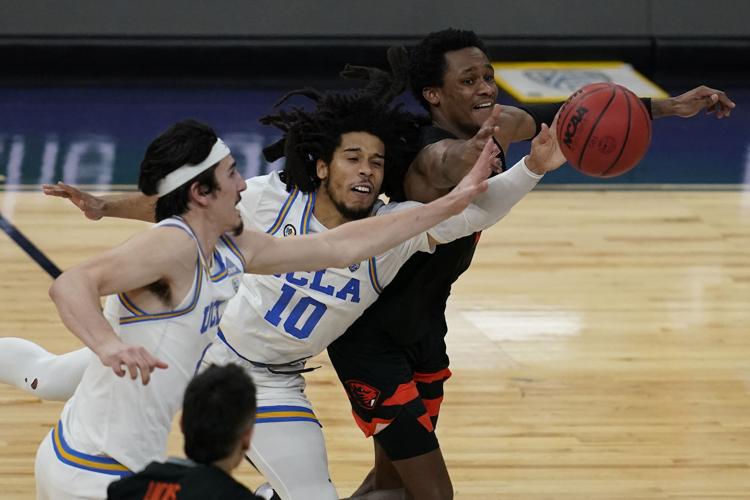The Pac-12’s disrupted basketball season has reached an unpredictable finish, with a sixth-place team, Oregon State, advancing to Saturday night’s conference tournament finals.
And there’s plenty more chaos to come: A slew of Pac-12 bracket matters must be resolved on Selection Sunday and — as we’ll explain below — perhaps early next week.
Our look at the top storylines ahead of the big reveal on Sunday afternoon:
Pac-12 bids
The conference will send at least three teams to March Madness: Colorado, USC and Oregon have locked up at-large bids.
Beyond that, the situation is muddled.
With four consecutive losses, UCLA has seemingly fallen onto the bubble. The Bruins are No. 47 in the NET rankings, a precarious position, and No. 46 in the Pomeroy efficiency ratings.
But no team is evaluated in a vacuum, and UCLA’s résumé compares favorably to the profiles of other contenders for the final at-large spots.
What the Bruins don’t have just might be their salvation: They don’t have any bad losses.
Consider UCLA’s record against:
Quad 1 opponents: 2-6
Quad 2 opponents: 3-3
Quad 3 opponents: 8-0
Quad 4 opponents: 4-0
The conference has a fifth team lurking.
Oregon State played Colorado late Saturday in a game that was still being played when the Star went to press. By winning, the Beavers could claim the Pac-12’s automatic berth and make their first appearance in March Madness since 2016.
They will also steal a bid from a bubble team hoping to sneak into the at-large field — perhaps even UCLA.
Meanwhile, a loss to the Buffaloes would eliminate OSU.
As the situation currently stands, the Pac-12 could send as few as three teams to the NCAAs, or as many as five.
Pac-12 seeds
We do not expect the conference to produce a top-four seed.
The highest-rated teams in the NET rankings, Colorado and USC, simply don’t have enough elite wins to support a No. 4 seed (or higher).
Our best guess is the Buffaloes and Trojans, along with Oregon, will land in the No. 5-7 seed range, with UCLA on the No. 10 or 11 line (if the Bruins make it).
Oregon State would be in that range, as well.
The more immediate issue is how many Pac-12 teams, if any, are slotted as No. 8 or 9 seeds.
That’s the death pairing, because of the second-round game against the No. 1.
All that said, the bracket reveal could feature more surprises than usual.
The reduction in non-conference games nationally (due to COVID) has limited the selection committee’s ability to make cross-conference comparisons.
The No. 1 seeds
At the top of the bracket, there is less drama than usual.
Gonzaga and Baylor are locks for No. 1 seeds, with Michigan and Illinois the heavy favorites to claim the other top spots.
And if one of those Big Ten powerhouses isn’t on the top line, the void could be fill by … another Big Ten team.
Iowa and Ohio State also have stout résumés, thanks to all the games played in the toughest conference in the country.
Alabama is the other contender. The Crimson Tide, which lost to Stanford by 18 points in late November, was the best team in the SEC all season.
Regional representation
The western third of the country is guaranteed to place six teams in the NCAA field: The tournament champions from the Pac-12, Mountain West, West Coast, Big Sky, Big West and WAC receive automatic bids.
The strength of college basketball in the west is measured by the number of at-large teams those conferences produce.
At this point, we envision three from the Pac-12, two from the Mountain West and one from the WCC.
Add the automatic qualifiers, and that’s 12 teams from the six conferences.
Put another way: Leagues that make up 18% of all Division I teams will account for … 18% of the tournament field.
The Replacements
There are several unusual aspects to March Madness in the COVID era, including the single-site nature of the event, with all games being played in Indianapolis.
Another fascinating piece: The replacements.
Once the bracket is announced, it’s locked. Even if a No. 1 seed is forced to withdraw next week, the pairings will remain fixed.
But because of the likelihood of disruption — we’ve seen several examples in conference tournaments this weekend — the selection committee has a backup plan.
In addition to revealing the 68 participants, the NCAA will release a list of four stand-by teams available as emergency replacements for the first round.
Envision a scenario in which UCLA doesn’t make the at-large field but is declared one of replacements.
If No. 1 seed Gonzaga were forced to withdraw on Monday or Tuesday because of positive COVID-19 tests, the Bruins would be subbed into the Zags’ slot — and face the No. 16 team in the first round.
Starting Wednesday, there will be no substitutions. If a team withdraws, the opponent advances by forfeiture.





